SECTION 100-01: Identification Codes
| 2014 Mustang Workshop Manual
|
DESCRIPTION AND OPERATION
| Procedure revision date: 02/21/2013
|
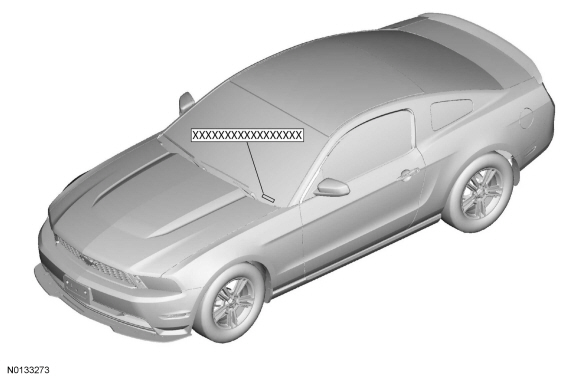
The Vehicle Identification Number (VIN) is a 17-digit alphanumeric code. The VIN is stamped on a metal tab riveted to the instrument panel, top upper left of the dash. The VIN number is also found on the Vehicle Certification (VC) label.
If the VIN plate requires replacement, authorized dealers must contact their respective regional office.
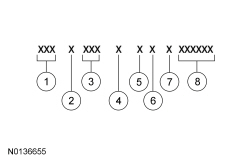
| Item | Description |
|---|---|
| 1 | World Manufacturer Identifier (WMI) |
| 2 | Restraint-type code |
| 3 | Line and series |
| 4 | Engine code |
| 5 | Computer-generated check digit |
| 6 | Model year code |
| 7 | Assembly plant code |
| 8 | Production sequence number |
Vehicle Identification Number (VIN)
The first 3 VIN positions are the World Manufacturer Identifier (WMI).
The fourth VIN position is the vehicle restraint system type code.
Positions 5 through 7 indicate vehicle line, series and body type.
The eighth VIN position is the engine displacement and number of cylinders code.
For more specific engine tag information (build date, etc.). Section 303-01A , Section 303-01B or Section 303-01C .
The ninth VIN position is a government-assigned, computer-generated check digit code (0-9).
The tenth VIN position is the model year code.
The eleventh VIN position is the assembly plant code.
The last 6 VIN positions are the production sequence number. This number is also used as the vehicle serial and warranty number.
The serial number can also be found on the engine block and transmission.
Vehicle Certification (VC) Label
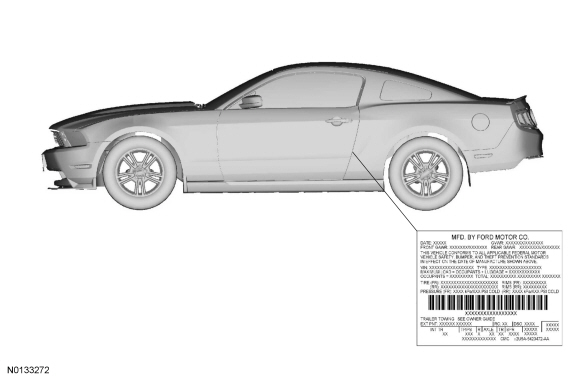
The upper portion of the Vehicle Certification (VC) label contains the manufacturer name, the month and year of manufacture, the certification statement and the Vehicle Identification Number (VIN). It also includes Gross Vehicle Weight Rating (GVWR). The VC label is located on the Left Hand (LH) door jamb.
If a vehicle requires replacement of the VC label and is 4 years old or less, an authorized dealer must submit the VIN to their respective regional office. The regional office will submit a web form to the assembly plant for the replacement label. Once the label has been printed, a representative from the regional office will deliver the label to the dealer and witness installation on the vehicle. If a vehicle is more than 4 years old and requires a replacement label, the dealer must submit a request to the Department of Motor Vehicles.
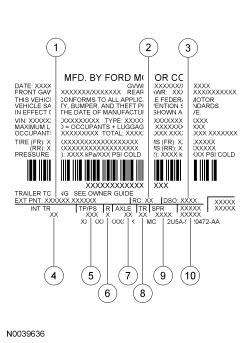
| Item | Description |
|---|---|
| 1 | Exterior paint color code |
| 2 | Region code |
| 3 | Special order code
District Special Order (DSO) FSO - foreign special order PTO - paint, tire option special order |
| 4 | Interior trim code |
| 5 | Tape/paint stripe code |
| 6 | Radio type code |
| 7 | Axle ratio code |
| 8 | Transmission code |
| 9 | Spring code |
| 10 | Powertrain calibration code |
Paint codes may be listed as a 2-part code. The first set of paint code letters/numbers listed indicate the vehicle primary body color. The second set of paint code letters/numbers listed (if applicable) indicate a 2-tone or accent body color. All colors are base coat/clear coat.
The interior trim codes are listed as a 2-part code. The first character listed is the interior fabric. The second character listed is the interior color.
The interior trim colors are:
The tape and paint stripe codes are:
The radio type codes are:
The axle ratios are:
For axle tag information, refer to Section 205-00 .
The transmission codes are:
For transmission tag information, refer to Section 307-01 , Section 308-03A , Section 308-03B .
The spring code portion of the VC label identifies both the front and rear springs. The first set of characters listed indicate the front spring code. The second set of characters indicate the rear spring code.
Powertrain Calibration Information
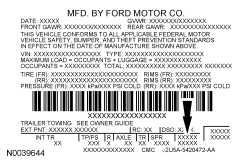
NOTE: Powertrain calibration information is limited to a maximum of 5 characters per line on the VC label. Because of this, calibration identification consisting of more than 5 characters will wrap to the second line on the VC label.
Powertrain calibration information is printed in the lower right corner of the VC label. Only the base calibration information is printed. Revision levels will not appear, however, this information can be obtained through a scan tool using the most current software revision.

| Item | Description |
|---|---|
| 1 | Model year (model year in which calibration strategy was first introduced) |
| 2 | Vehicle code |
| 3 | Transmission code |
| 4 | Unique calibration (designates different hardware to similar vehicles), example: tires or drive ratios |
| 5 | Fleet code (describes fleet to which the vehicle belongs), example: 6 - Evaporative Emission (EVAP) |
| 6 | Certification region (lead region where multiple regions are included in one calibration), example: A - US federal |
| 7 | Revision level (will advance as revisions occur), not printed on label |
The Emissions/Corporate Average Fuel Economy/Carbon Dioxide Compliance Department is responsible for assigning these calibration numbers. Unique calibration identifications are assigned to cover similar vehicles to differentiate tires, drive configurations, final drive ratios and other calibration-significant factors.
These 2 characters are chosen by the analyst to provide easily identifiable information unique to each calibration. For example, using the number 2 to denote a 2-valve engine versus using the number 4 to denote a 4-valve engine.